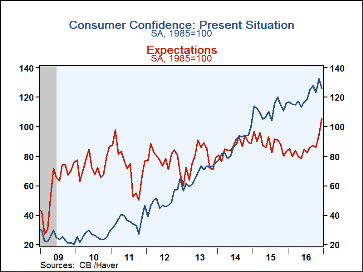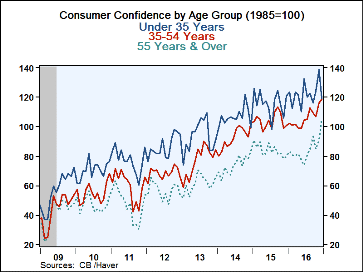 Global| Dec 27 2016
Global| Dec 27 2016U.S. Consumer Confidence Soars to 15-year High
by:Sandy Batten
|in:Economy in Brief
Summary
U.S. consumers are feeling a lot more optimistic about the future in December, according to The Conference Board Index of Consumer Confidence. It reported that its headline consumer confidence index for December jumped up to 113.7, [...]
U.S. consumers are feeling a lot more optimistic about the future in December, according to The Conference Board Index of Consumer Confidence. It reported that its headline consumer confidence index for December jumped up to 113.7, its highest level since August 2001. And November's reading was revised up to 109.4 from 107.1. Action Economics Forecast Survey had looked for a modest increase to 108.3 in December. During the past thirty years, there has been a 70% correlation between the level of consumer confidence and the y/y change in real PCE.
The jump in confidence in December was due to improved expectations concerning the future. The present situation index slipped to 126.1 in December from 132.0 in November, while the expectations index surged more than 10 points to 105.5 from 94.4.
Consumers' assessment of present conditions declined in December. Those saying business conditions are "good" decreased slightly from 29.7% to 29.2%, while those saying business conditions are "bad" increased from 15.2% to 17.3%. Consumers' appraisal of the labor market was also less positive than last month. Those stating jobs are "plentiful" declined from 27.8% to 26.9%, while those claiming jobs are "hard to get" increased from 21.2% to 22.5%. This change in views on labor market conditions led to a modest decline in the labor market differential (a reliable indicator of the unemployment rate) to 4.4%-pts from 6.6%-pts in November, but the November reading was the high for the current expansion.
In contrast to consumers' views on the current environment, their outlook for both business and labor market conditions improved markedly in December. The percentage expecting business conditions to improve over the next six months jumped to 23.6% in December from 16.4% in November. For labor markets, the percentage expecting more jobs in the months ahead increased to 21% in December from 16.1% in November. And the percentage of consumers expecting their incomes to rise rose to 21.0% from 17.4% in November.
With the Federal Reserve having raised its key policy interest rate in mid-December and market rates on the rise since the U.S. presidential election, consumers are looking for further increases ahead. The percentage expecting higher interest rates over the next twelve months rose to 69.0% in December from 63.0% in November. The December reading was the highest since January.
The improvement in the headline index was due mostly to increased optimism in the 55 years and over group. Confidence among individuals under 35 years old slumped to 118.9 from 138.5 in November. However, the November reading was a 15-year high. Confidence rose in the other two age groups. It edged up to 118.6 from 116.0 among those 35-54 years old, and surged to 105.5 from 90.7 for those 55 years and older--a new high for the current expansion.
The Consumer Confidence data is available in Haver's CBDB database. The total indexes appear in USECON, and the market expectations are in AS1REPNA
| Conference Board (SA, 1985=100) | Dec | Nov | Oct | Y/Y % | 2015 | 2014 | 2013 |
|---|---|---|---|---|---|---|---|
| Consumer Confidence Index | 113.7 | 109.4 | 100.8 | 18.1 | 98.0 | 86.9 | 73.2 |
| Present Situation | 126.1 | 132.0 | 123.1 | 8.3 | 111.7 | 87.4 | 67.6 |
| Expectations | 105.5 | 94.4 | 86.0 | 27.1 | 88.8 | 86.6 | 77.0 |
| Consumer Confidence By Age Group | |||||||
| Under 35 Years | 118.9 | 138.5 | 124.1 | -1.4 | 116.0 | 106.6 | 93.1 |
| Aged 35-54 Years | 118.6 | 116.0 | 106.9 | 17.9 | 103.9 | 92.4 | 76.8 |
| Over 55 Years | 105.5 | 90.7 | 84.6 | 32.2 | 84.1 | 73.8 | 61.2 |
Sandy Batten
AuthorMore in Author Profile »Sandy Batten has more than 30 years of experience analyzing industrial economies and financial markets and a wide range of experience across the financial services sector, government, and academia. Before joining Haver Analytics, Sandy was a Vice President and Senior Economist at Citibank; Senior Credit Market Analyst at CDC Investment Management, Managing Director at Bear Stearns, and Executive Director at JPMorgan. In 2008, Sandy was named the most accurate US forecaster by the National Association for Business Economics. He is a member of the New York Forecasters Club, NABE, and the American Economic Association. Prior to his time in the financial services sector, Sandy was a Research Officer at the Federal Reserve Bank of St. Louis, Senior Staff Economist on the President’s Council of Economic Advisors, Deputy Assistant Secretary for Economic Policy at the US Treasury, and Economist at the International Monetary Fund. Sandy has taught economics at St. Louis University, Denison University, and Muskingun College. He has published numerous peer-reviewed articles in a wide range of academic publications. He has a B.A. in economics from the University of Richmond and a M.A. and Ph.D. in economics from The Ohio State University.










